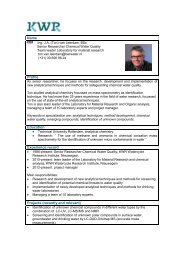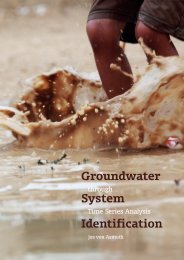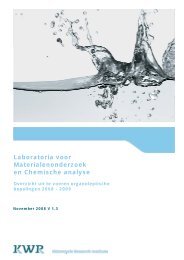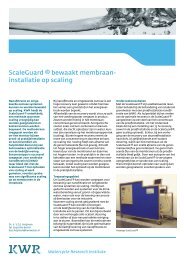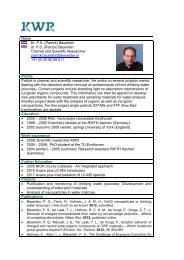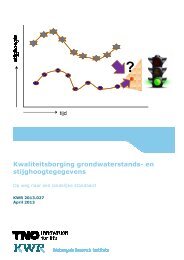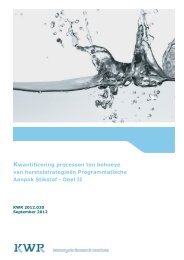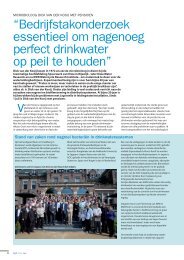Menyanthes User Manual - KWR Watercycle Research Institute
Menyanthes User Manual - KWR Watercycle Research Institute
Menyanthes User Manual - KWR Watercycle Research Institute
- No tags were found...
Create successful ePaper yourself
Turn your PDF publications into a flip-book with our unique Google optimized e-Paper software.
minimum duration of that period. You can choose the level and period of the year forwhich the analysis is made.• Regime Curves are shown at the bottom right hand corner. In the Regime Curves framethe option All regime curves displays the individual groundwater hydrographs ofevery year. Based on these, the average, and some specified percentiles may becomputed and plotted.6.2 Calculation of groundwater statisticsGroundwater statistics produced by <strong>Menyanthes</strong> for selected groundwater level series arecalculated in three steps:• Data clearing – First, only the years are selected in which sufficient observations areavailable. When there is a gap of more than two months in the data, the year in whichthe gap occurs is left out of the calculations. If the gap stretches over two years, theyears in which data is missing over more than one month are disregarded.• Selection and/or interpolation – Next, if necessary, the data are interpolated linearly inorder to obtain a series with regular time steps and values on the 1 st , 8 th , 16 th and 23 rd ofevery month.• Statistical calculations – Most statistics are calculated using the resulting time seriesdescribed above. The MxGL statistics, however, are calculated using bi-monthlyobservations, following their definition by [Van der Sluijs and De Gruijter, 1985; Van der Sluijs,1990] .MxGL statistics and Groundwater level classes – The methods with which <strong>Menyanthes</strong>calculates the MxGL statistics and Groundwater level classes are based on [Van der Sluijs andDe Gruijter, 1985; Van der Sluijs, 1990]. First the xGL3’s are computed by averaging the threeHighest, Lowest or Spring groundwater levels of every year. The three Spring GroundwaterLevels, however, are the three values closest to the first of April, i.e. March 16 and April 1 and16. Next, the MxGL is computed by averaging the resulting xGL3’s. According to [Van derSluijs, 1990] at least 8 years of observations have to be available in order to calculate the MxGLstatistics. This restriction, however, is deliberately not implemented in <strong>Menyanthes</strong>, so MxGLstatistics can be also calculated for shorter time series. Note, however, that the duration of theobservation period does influence the accuracy of the results.NOP-graphs – NOP stands for ‘Number of Periods Graph’. A NOP-graph is generated bycalculating the number of times that the groundwater level is below or above a certain level.This is done for all years separately. The NOP-graph is a plot of the average number of periodsin a year that the groundwater level is higher or lower than a certain level (plotted on the y-axis), against the minimum duration of such a period (plotted on the x-axis). This graph andthe calculation method were specifically designed for the Dutch State Forestry Service. Theirpurpose is that different plant species have different sensitivities for periods of inundation ofdifferent length, and the resulting lack of oxygen in the root zone. The latter factor is alsoinfluenced by the (growing) season or temperature at which it occurs.Attention:• Interpolation affects the statistical properties of a series. If data is only available at a lowfrequency and/or contains a lot of gaps, we recommend the use of a time series model tofill the gaps and simulate groundwater levels on a higher frequency and over a longerperiod. The simulated series can then be used to calculate more reliable statistics.<strong>Menyanthes</strong> <strong>Manual</strong>© <strong>KWR</strong> - 24 -



